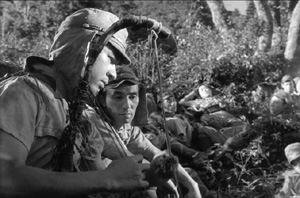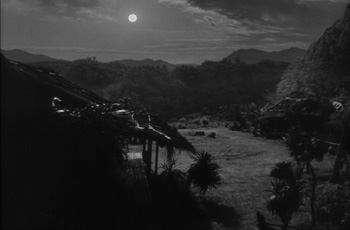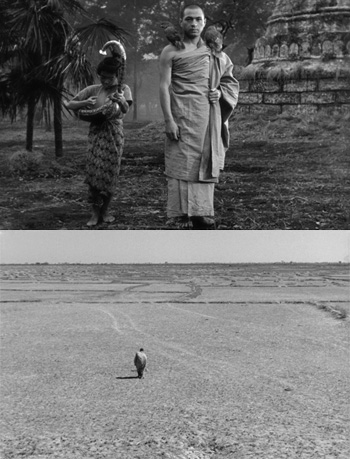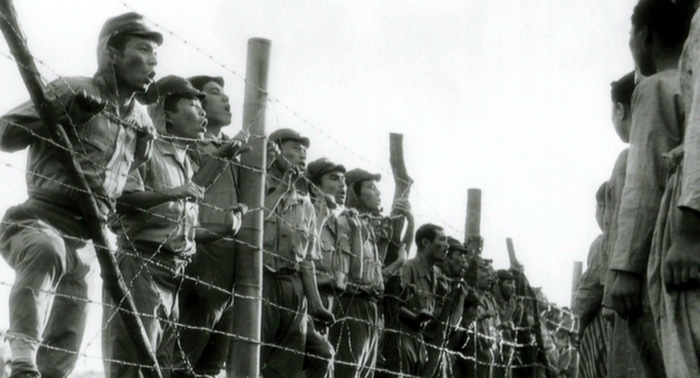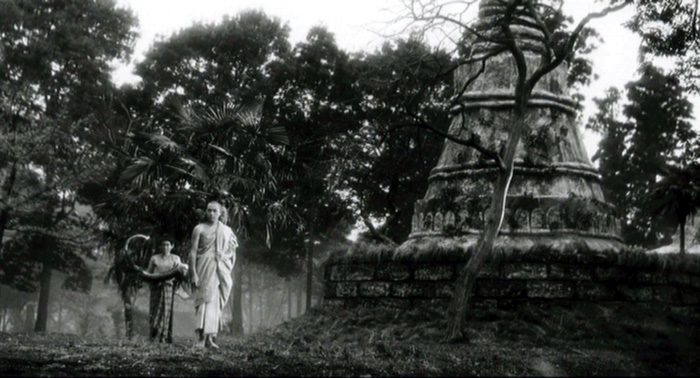 In the aftermath of World War II, a Japanese soldier disguises himself as a Buddhist monk in Kon Ichikawa`s masterpiece THE BURMESE HARP. © 1956 Nikkatsu Corporation
In the aftermath of World War II, a Japanese soldier disguises himself as a Buddhist monk in Kon Ichikawa`s masterpiece THE BURMESE HARP. © 1956 Nikkatsu CorporationThe Criterion Collection Presents a Post-War Masterpiece by Director Kon Ichikawa Author: John “Dutch” DeSentis Source: The Criterion Collection SPOILER WARNING: The following review contains plot details for THE BURMESE HARP so if you would like to avoid them, just skip right down to the section on the DVD itself.
THE MOVIE
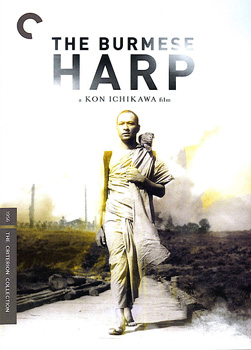 Cover art for the Criterion Collection`s new DVD of THE BURMESE HARP. © 1956 Nikkatsu Corp./2007 Criterion
Cover art for the Criterion Collection`s new DVD of THE BURMESE HARP. © 1956 Nikkatsu Corp./2007 Criterion “The soil of Burma is red, and so are its rocks...” These are the words that open the film THE BURMESE HARP right after the title crawl across the barren landscape. The movie, based on a novel written by Takeyama Michio and released in Japan as BIRUMA NO TATEGOTO in 1956, tells the story of a man stationed in Burma named Yasuhiko Mizushima (Shoji Yasui) who happens to have a natural ability to play the harp. His commander, Captain Inouye (Rentaro Mikuni), was a music school graduate who taught his men the basics of chorus. Together with Captain Inouye’s musical direction and Mizushima’s talent, the troops would often sing to battle being homesick and keep their spirits up. The troop prepares for a siege one night as British and Indian troops converge on the small village that they are taking refuge at. The Japanese soldiers begin to sing the song “Hanyu no Yado” to give the enemy troops the impression that they don’t know they are there. The British troops, however, recognize the song and begin to sing in return. The song that the Japanese troops are singing turns out to be a version of the old English folk song “Home Sweet Home”. Peace is brought about with music and the Japanese troops surrender their arms without a fight. It is then that they find out that the War has ended and the nation of Japan has surrendered.
Mizushima is asked by the British troops via Captain Inouye to go North and persuade a group of soldiers holding out on a mountain to surrender or face death. Mizushima agrees and carries his harp up the mountain. When he reaches the troops, he tries to persuade them to lay down their arms as Japan has surrendered. The Captain and his troops refuse to believe it and maintain that they will fight to the death. They pay the ultimate price with their lives. Mizushima is wounded but is found by a Buddhist monk who cares for him and nurses him back to health. Mizushima is transformed by what he has seen and turns himself into a monk. He makes a trek on foot South to reunite with his brothers at arms, who are all at a prison camp in Mudon. On his way, his spiritual journey deepens as he witnesses thousands of dead Japanese soldiers piling up in the forests and along the shores. It is then that he realizes he has a mission and that is to make sure that all the war dead are buried.
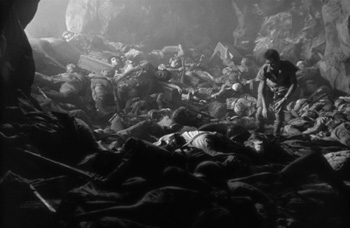 Despite Mizushima`s efforts, a holdout troop of Japanese soldiers are wiped out after they refuse to surrender to British forces. © 1956 Nikkatsu Corp.
Despite Mizushima`s efforts, a holdout troop of Japanese soldiers are wiped out after they refuse to surrender to British forces. © 1956 Nikkatsu Corp.THE BURMESE HARP is a very powerful and moving film. Its prime message is that music is a universal and uniting language of peace. Nowhere is this more prevalent than the scene in which the Japanese and English soldiers are singing the same song in two different languages. The choice of the song “Home Sweet Home” also shows that being homesick is universal and affects everyone. THE BURMESE HARP was director Kon Ichikawa’s breakthrough movie as it gained international recognition and won the San Giorgio prize at the 1956 Venice Film Festival (although in the recorded interview that accompanies the DVD Ichikawa says he wasn’t even aware the movie was entered in the festival until after it won!). The movie is anchored in music and what better composer to have working on it than Akira Ifukube, who was entering a period where he was increasingly sought after. Fans of Godzilla movies will actually recognize the main tragedy theme in THE BURMESE HARP as it is the same music Ifukube used to represent devastated Tokyo in GODZILLA (Gojira, 1954) and also the music during the underwater climax. Both in GODZILLA and in this movie, this music underscores the tragedy of the war although the movies have different ways of approaching the subject. Ifukube’s other pieces of music which represent the sounds of the harp are beautiful and equate to poetry for the ears.
There have been times when the movie has come under fire for its portrayal of Japanese soldiers during World War II. Many of the critics find it hard to accept that there soldiers as moral and as sensible as Mizushima and Captain Inouye. As pointed out in the booklet that comes with the DVD, film scholar Joan Mellen attacked the film calling it “a sentimental if often beautiful whitewash of the Japanese presence in Southeast Asia”. The truth of the matter is that this film does not attempt to conceal anything in regards to Japanese atrocities during World War II although it doesn’t directly address them. This is most likely because such incidents were not reported in Japan until many, many years after the war. The booklet explains this in further detail. There are notable moments in the film that point to this as well. Burmese natives react with scorn when the Japanese soldiers come into their town to seek refuge for the night. It is clear that they are not happy with their presence. Also, the military group that Mizushima pleads with to surrender perfectly fit the “fight to the death” mentality that many Japanese soldiers had during the war. The commander calls Mizushima and his company a bunch of cowards and essentially bullies his men into fighting to the death. It is this kind of mentality that shows the true tragedy of war and ultimately what begins Mizushima on his spiritual journey. Mizushima’s unit and his Captain are an anomaly. They all realize that fighting to the death does not serve to make Japan better after all. They instead choose to realize that returning home safely and rebuilding their nation is what’s to be done now that the war is over. While at Mudon, the Captain tells his men that they all will return together with no man left behind. Mizushima, however, realizes he must stay behind because so many thousands of dead soldiers are left to rot. He has a desire to spiritually make right what he has done wrong in the war. All this is revealed in a touching letter that he sends to his company just before they disembark for Japan. Overall, the movie is a great story which presents a frank and sometimes gruesome look at the horrors of war that both sides no doubt suffer. It is great to have this classic on DVD in the west.
THE DVD
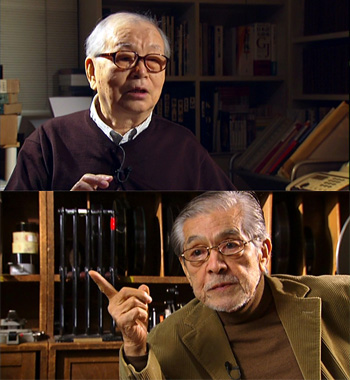 Director Kon Ichikawa and actor Rentaro Mikuni were both interviewed for the new DVD. © 2007 The Criterion Collection
Director Kon Ichikawa and actor Rentaro Mikuni were both interviewed for the new DVD. © 2007 The Criterion CollectionCriterion has been renowned for its incredible presentations of important and classic films. Many of famed director Akira Kurosawa’s movies have been the subject of royal treatment in regards to their DVD releases. THE BURMESE HARP, along with another Kon Ichikawa movie called FIRES ON THE PLAIN (Nobi, 1959), was released on March 13th and is given a stunning presentation. The restoration of picture and sound is superb. There is nary a speck of dirt on the transfer, which has been cleaned up using the MTI Digital Restoration System. The DVD is duel-layered and encoded at the highest possible bit rate. The sound quality is also incredible with audio that is devoid of hiss, crackles, and pops. Of course, there are very minor instances where you can hear some aging but what do you want on a movie that is 51 years old? The special features on the DVD are nowhere near what they are on other Criterion releases. There are, however, a few goodies on here. The mandatory movie trailer is, of course, present. There are also two interviews done especially for this disc with director Kon Ichikawa and actor Rentaro Mikuni (Captain Inouye). The interview with Ichikawa is especially interesting as he talks about the various aspects of making the movie and translating it from novel to film. He also talks about the selection of sounds for the music with Akira Ifukube and even mentions how he and Ifukube argued a lot over musical direction of the film. This fits with Ifukube’s well known reputation in the early days of being somewhat argumentative with directors. Rounding out the package is a booklet with movie credits, photos, and a 9 page essay on THE BURMESE HARP by film historian Tony Rayns.
Overall, the disc is a little thin in regards to special features but it’s not like there were documentaries already made and simply in need of translation like on the Kurosawa DVDs. Criterion did manage to make a decent presentation that is not even close to being “bare bones”. The packaging art is also well done with a stark picture of a monk-robed Mizushima on the cover. At the end of the day, Criterion has once again done an excellent release of a revered Japanese classic. The DVD is definitely worth the buy and the movie worthy of permanent preservation in this wonderful format.
Technical Information
Disc Distributor: The Criterion Collection Catalogue Code: CC1685D UPC Code: 7-15515-02272-9 Retail Price: $29.95 Discs: 1 Region Code: 1 (North America) Colour System: NTSC DVD Format: Single Sided & Dual Layered Video Ratio: 1.33:1 Main Feature Runtime: 116 mins Main Feature Chapter Stops: 24 Main Feature Audio Tracks: Japanese and Burmese (Dolby Digital 1.0) Main Feature Subtitles: English


